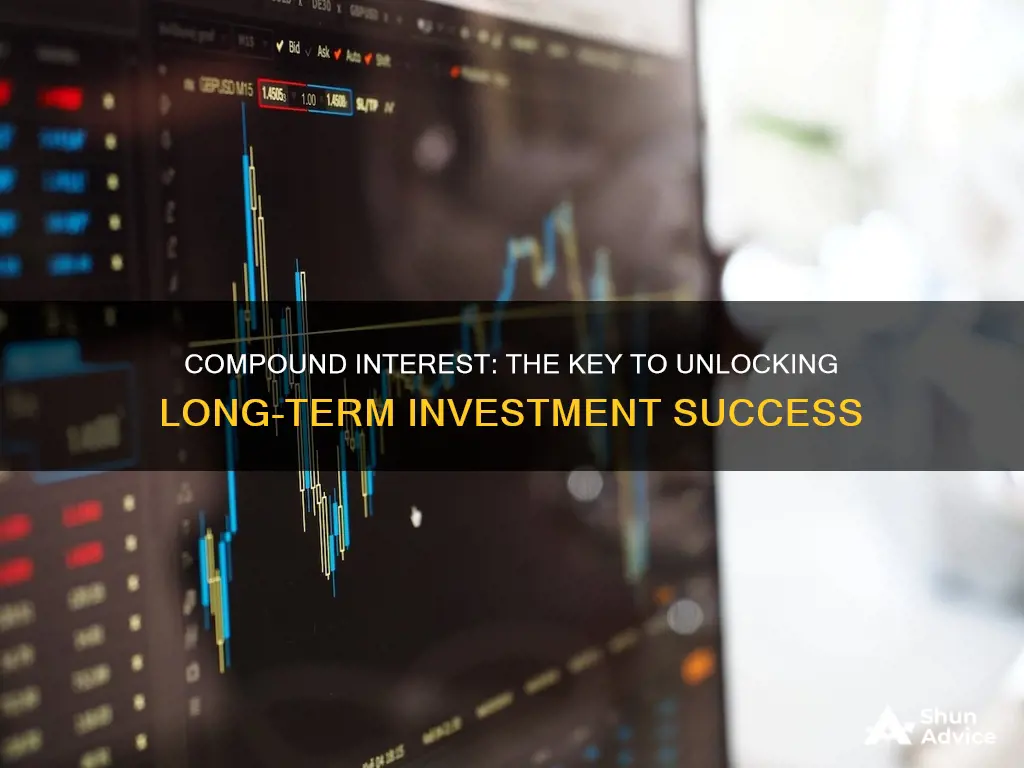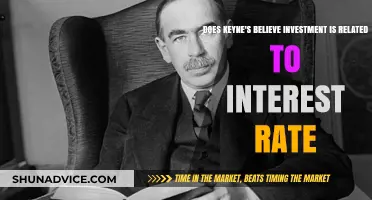
Compound interest is a powerful tool for investors, offering a significant advantage over simple interest. When an investment earns compound interest, the interest earned is added to the principal, and subsequent interest is calculated on the new total. This means that over time, the investment grows exponentially, resulting in a much larger final amount. In contrast, simple interest only applies to the initial principal, and the interest earned does not contribute to further growth. As a result, compound interest provides a more substantial return on investment, making it a preferred choice for those seeking long-term wealth accumulation.
What You'll Learn
- Long-Term Growth: Compound interest allows investments to grow exponentially over time, outpacing simple interest
- Compounding Frequency: More frequent compounding periods (daily, monthly) enhance the power of compound interest
- Higher Returns: Compound interest yields higher returns, especially in long-term investments, due to its compounding effect
- Risk Mitigation: Compound interest reduces the risk of principal erosion, ensuring a more stable investment growth
- Tax Efficiency: Compound interest can be more tax-efficient, as it generates returns that are reinvested and grow tax-free

Long-Term Growth: Compound interest allows investments to grow exponentially over time, outpacing simple interest
Compound interest is a powerful tool for investors, offering a significant advantage over simple interest, especially when considering long-term growth. When you invest money, the interest earned is often added to the principal amount, and this new total then earns interest in subsequent periods. This process is known as compounding, and it has a profound impact on the growth of your investment.
In simple interest, the interest earned is calculated only on the initial principal amount. For example, if you invest $1000 at a simple interest rate of 5%, you will earn $50 in interest each year, and the total amount after one year will be $1050. While this provides a steady growth rate, it is linear and does not accelerate over time.
However, with compound interest, the story is very different. Each time interest is added to the principal, it earns interest in the next period, and this process repeats. This exponential growth means that your investment can increase at an accelerating rate. For instance, if you invest $1000 at an annual compound interest rate of 5%, after the first year, you will have $1050. In the second year, you earn interest on this new total, so you make $52.50 in interest, bringing the total to $1102.50. This pattern continues, and the growth becomes increasingly rapid.
Over the long term, this exponential growth can lead to substantial gains. The power of compounding is such that the difference between simple and compound interest becomes more pronounced as the investment period extends. For instance, over a 20-year period, an investment of $10,000 with a 5% annual compound interest rate could grow to approximately $26,530, while the same amount invested at a simple 5% interest rate would only grow to $15,000. This demonstrates how compound interest can significantly enhance the value of your investments over time.
Understanding the concept of compounding is essential for investors as it highlights the importance of starting early and allowing time for the power of compound interest to work its magic. The longer the investment period, the more significant the advantage of compound interest over simple interest. This is why many financial advisors emphasize the benefits of long-term investing, utilizing compound interest to build wealth over time.
Unleash the Power of Compound Interest: A Catalyst for Investment Success
You may want to see also

Compounding Frequency: More frequent compounding periods (daily, monthly) enhance the power of compound interest
The concept of compounding frequency is a crucial aspect of understanding the power of compound interest. When we talk about compounding, we refer to the process where interest is calculated and added to the principal amount, and then interest is earned on the new, higher balance. This process repeats over time, leading to exponential growth. The more frequently this process occurs, the greater the impact of compound interest.
In the context of investing, the frequency of compounding can significantly influence the final value of an investment. For instance, consider an investment of $10,000 with an annual interest rate of 5%. If this interest is compounded annually, the investment will grow to $12,500 in one year. However, if the same interest rate is applied daily, the investment will grow to $12,605 in just one year. This example demonstrates how more frequent compounding periods can lead to a higher final amount.
The reason for this lies in the mathematical nature of compound interest. When interest is compounded more frequently, the interest earned in each period is calculated based on a larger principal amount. This means that even a small amount of interest in each period can lead to a significant increase in the overall value of the investment over time. For instance, daily compounding will result in more interest being added to the principal each day compared to annual compounding, leading to a larger balance after a year.
This effect is particularly noticeable over longer investment periods. The more frequent the compounding, the more times the interest is calculated and added, leading to a snowball effect. This is why investors often prefer more frequent compounding periods, especially when dealing with long-term investments. For example, a 5% annual return compounded monthly over 20 years will result in a final value that is significantly higher than the same return compounded annually.
In summary, more frequent compounding periods enhance the power of compound interest by providing a more substantial base for interest to be calculated upon. This results in a faster growth rate for investments, making compound interest a more attractive option for investors looking to maximize their returns over time. Understanding the impact of compounding frequency is essential for making informed investment decisions and can significantly influence the success of long-term financial strategies.

Higher Returns: Compound interest yields higher returns, especially in long-term investments, due to its compounding effect
Compound interest is a powerful tool for investors, offering a significant advantage over simple interest, particularly in long-term investment strategies. The concept of compound interest is simple: instead of earning interest only on the initial principal amount, it also includes interest on the accumulated interest from previous periods. This compounding effect is what makes compound interest so beneficial.
When you invest a sum of money, the interest earned in the first year will be added to the principal, and in the subsequent years, interest will be calculated on this new total. This process repeats, leading to exponential growth in the value of your investment over time. For example, if you invest $10,000 at an annual interest rate of 5% compounded annually, after the first year, you'll earn $500 in interest, making your total $10,500. In the second year, you'll earn 5% interest on this new total, resulting in $525 in interest and a grand total of $11,025. This compounding effect accelerates the growth of your investment, making it a more attractive option for long-term financial goals.
The power of compound interest becomes even more evident over extended periods. In a 30-year investment, the difference between simple and compound interest can be substantial. With simple interest, your returns remain constant, but with compound interest, they grow exponentially. This is why many financial experts recommend starting to save or invest early in life, as the longer investment period allows compound interest to work its magic, potentially doubling or tripling your initial investment.
For instance, consider an investment of $10,000 at 5% interest for 30 years. With simple interest, you'd earn $15,000 in interest, totaling $25,000. However, with compound interest, the calculation is more complex but ultimately more rewarding. The total would be approximately $43,705, a significant difference of over $18,000. This example highlights how compound interest can lead to substantial gains, making it a preferred choice for long-term financial planning.
In summary, compound interest is preferable to simple interest when investing because it provides higher returns, especially over extended periods. The compounding effect ensures that your investment grows at an accelerating rate, allowing you to achieve your financial goals faster and with greater success. Understanding this concept is crucial for anyone looking to make the most of their investment strategies.

Risk Mitigation: Compound interest reduces the risk of principal erosion, ensuring a more stable investment growth
Compound interest is a powerful tool for investors, offering a more stable and secure growth path compared to simple interest. One of the key advantages of compound interest is its ability to mitigate risk and ensure the preservation of the principal amount invested.
When an investment earns compound interest, the interest earned is added back to the principal, and subsequent interest calculations are based on the new, larger amount. This process creates a snowball effect, where the initial investment grows exponentially over time. As a result, the risk of principal erosion is significantly reduced. Principal erosion refers to the gradual loss of the initial investment due to the accumulation of interest, which can be detrimental to long-term financial goals. With compound interest, the principal remains intact, and the investment grows at an accelerating rate, providing a more reliable and secure financial outcome.
The power of compound interest becomes especially evident over extended periods. As time progresses, the interest earned on the initial investment compounds, and the total amount grows exponentially. This growth pattern ensures that the investment remains on track to meet its financial objectives, even in the face of market fluctuations or economic downturns. For instance, consider an investor who starts with a $10,000 investment. With compound interest, this amount could grow to $16,000 in 10 years, $32,000 in 20 years, and so on. This growth trajectory demonstrates how compound interest can provide a more stable and robust investment strategy.
In contrast, simple interest calculations do not take into account the compounding effect. This means that the interest earned remains fixed, and the principal amount is not utilized to generate additional returns. As a result, simple interest can lead to a faster erosion of the principal, especially over longer investment periods. For example, if the same $10,000 investment earns simple interest, the total amount after 10 years would be $13,000, and after 20 years, it would be $16,000, which is significantly lower than the compound interest scenario.
By understanding the concept of risk mitigation through compound interest, investors can make more informed decisions. It encourages a long-term investment mindset, where the focus is on building wealth steadily and securely. Compound interest's ability to preserve the principal and accelerate growth makes it an essential strategy for investors seeking stable and reliable financial returns. This approach ensures that the investment journey is more manageable and aligned with the investor's goals, providing a sense of security and confidence in the market.

Tax Efficiency: Compound interest can be more tax-efficient, as it generates returns that are reinvested and grow tax-free
Compound interest is a powerful tool for investors, offering a more efficient and effective way to grow their wealth over time. One of the key advantages of compound interest is its ability to provide tax efficiency, which can significantly impact an investor's overall returns. When an investment generates returns, these returns can be reinvested, allowing the investment to grow exponentially. This process is known as compounding, and it has a profound effect on the tax treatment of the investment.
In many jurisdictions, the tax system treats reinvested earnings differently from initial capital. When an investor receives simple interest, the interest earned is typically taxable income, and the investor must pay taxes on it. However, with compound interest, the returns are reinvested and become part of the principal amount, growing tax-free. This is because the reinvested earnings are not considered new income but rather a continuation of the initial investment. As a result, the investor benefits from the growth of the investment without incurring additional tax liabilities on the reinvested returns.
The tax efficiency of compound interest becomes particularly advantageous in long-term investments. Over extended periods, the cumulative effect of reinvesting returns can be substantial. Each year, the investment grows not only by the initial capital but also by the accumulated interest from previous years. This exponential growth can lead to significant tax savings, as the investor avoids paying taxes on the reinvested earnings multiple times.
For example, consider an investor who starts with an initial investment of $10,000 and earns a 5% annual compound interest rate. After the first year, the investment grows to $10,500, and the $500 interest earned is reinvested. In the second year, the $10,500 grows to $11,025, and the $525 interest is reinvested, and so on. Over time, the investment's value increases, and the tax burden on the reinvested returns becomes less significant. This strategy allows investors to maximize their after-tax returns, making compound interest a preferred choice for long-term wealth accumulation.
In summary, compound interest offers a tax-efficient approach to investing due to its ability to generate returns that are reinvested and grow tax-free. This advantage is particularly beneficial for long-term investments, where the cumulative effect of compounding can lead to substantial tax savings. By understanding the tax implications of simple versus compound interest, investors can make informed decisions to optimize their investment strategies and potentially increase their overall financial gains.
Frequently asked questions
Compound interest is calculated on the initial principal amount and the accumulated interest from previous periods. It means that the interest earned each period is added to the principal, and the subsequent interest is calculated on this new total. Simple interest, on the other hand, is calculated only on the initial principal amount, and it does not consider the compounding effect.
Compound interest is a powerful tool for investors as it allows their money to grow exponentially over time. With compound interest, the investor's money earns interest, and then that interest also earns interest in subsequent periods. This compounding effect can significantly increase the final amount, making it a preferable choice for long-term investments.
Let's say an investor puts $10,000 into an account with an annual interest rate of 5%. Over 10 years, the simple interest would be $5,000 (10,000 * 0.05 * 10), resulting in a total of $15,000. However, with compound interest, the interest is added to the principal, and the next year's interest is calculated on this new total. This leads to a higher final amount, demonstrating the power of compounding.
The frequency of compounding plays a crucial role in investment growth. The more often interest is compounded, the faster the balance grows. For example, daily compounding will result in more significant growth compared to annual compounding over the same period. Investors should consider the compounding period when choosing investment options to maximize their returns.
While compound interest offers significant benefits, it's essential to understand that the longer the investment period, the more significant the potential advantage. However, the risk of market volatility and other factors can impact the actual returns. Additionally, some investment products may have higher fees or taxes, which can reduce the overall benefit of compound interest. Investors should carefully consider their investment strategy and seek professional advice when needed.







